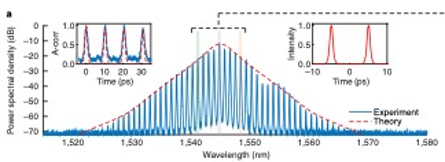Nested fibre laser microcombs
Frequency combs are a series of sharp, precisely spaced, and pyramidal spectral lines covering a large bandwidth of the optical spectrum. Optical frequency combs based on microcavity resonators, also called ‘microcombs’, offer the promise of achieving their full capability on an integrated footprint. They have enabled major breakthroughs in spectroscopy, communications, microwave photonics, frequency synthesis, optical ranging, quantum sources, metrology and astrocombs.
Of particular importance for microcombs has been the use of temporal cavity-solitons in microcavities. Temporal cavity-solitons are an important example of dissipative solitons—self-confined waves balancing dispersion with the nonlinear phase shift in lossy systems. In a key collaboration with the group of Alessia Pasquazi at the University of Sussex, laser based cavity-soliton microcombs have been demonstrated for the first time in a nested fibre laser device formed by a fibre loop with gain and a nested Kerr micro-resonator (Figure 2). Figure 3 shows the experimental frequency microcomb, its theoretical envelope and the profiles of the laser temporal cavity-solitons in a succesfull comparison between experiments and theory.
|
|
 |
| Fig. 2: Experimental set-up formed by a fibre loop with gain and a nested Kerr micro-resonator | Fig. 3: Frequency microcomb. A comparison of the laser temporal cavity solitons is shown in the inset on the left side. |
Recent Reference
H. Bao, A. Cooper, M. Rowley, L. Di Lauro, J. S. Totero Gongora, S. T. Chu, B. E. Little, G.-L. Oppo, R. Morandotti, D. J. Moss, B. Wetzel, M. Peccianti and A. Pasquazi, “Laser cavity-soliton microcombs”, Nature Photonics 13, 384 (2019).
